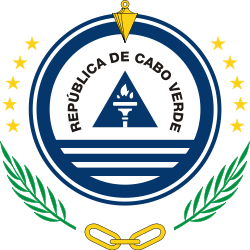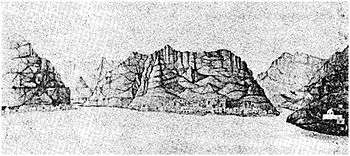Timeline of Santo Antão, Cape Verde
Part of a series on the |
|---|
| History of Cape Verde |
 |
| Colonial history |
| Independence struggle |
|
|
The following is a timeline of the island of Santo Antão, Cape Verde.
Prehistoric era
- Around 2 to 1 million years ago: Bordeira Group of rock formation formed
- Around 1.4 million to 700,000 yearws ago: Cova Group of rock formation formed
- Around 400,000 years ago: the Proto-Coroa formation formed[1]
- Around 300,000 years ago: Àgua Nova Group of rock formation formed
- Around 200,000 years ago: Last eruption occurred at Topo da Coroa, the type was a Plinian, it later formed the Coroa and Young Tarrafal rock formations[1]
- Around 100,000 years ago: Lagoa formation formed[1]
- Up to about 5,000 years ago: The island was larger and compromised an estimate size of 800 km2 of land, it separated São Vicente between 500 meters to 1 kilometer. Flooding took place and the São Vicente Channel was widened up to 10 km about 8,000 to 6,000 years ago and later to its current 12 km length.
- Around 4,000 BC: Topo da Coroa's elevation dropped below 2,000 meters above sea level after sea level rose
Colonial era
See also: Timeline of Portuguese Cape Verde
- 1462 - January 17: The island was discovered by the Portuguese explorer Diogo Afonso, it was discovered after São Nicolau and before São Vicente and Santa Luzia
- 1494 - The old Treaty of Tordesillas which was put on June 7, 1494 between Portugal and the Kingdom of Castile that determined the division of the areas of influences of the Iberian countries it marked the line of discovered and then undiscovered lands with an imaginary line located 370 leagues (1,770 km) west of the island, marked at the westernmost point west of Monte Trigo
- 1548
- January: First settlement (either Fontainhas or Ponta do Sol) established on the island, first time the island was populated
- January 13: Gonçalo de Sousa was the only capitain of the island for some years
- Mid-17th century - People from Santiago, Fogo along with people from northern Portugal inhabited the area around today's Ribeira Grande, a settlement would be founded there
- 18th century - Jewish people inhabited a part of the island and founded Sinagoga
- 1724 - the British posessed and ruled the island, it was soon returned to the Portuguese
- 1732 - Ribeira Grande elevated to a town
- 1832 - Approximate population: 24,000[2]
 Cove of Ribeira Grande in the mid 19th century
Cove of Ribeira Grande in the mid 19th century - Mid 19th century - Sugar became the island's main crop
- 1859 - Along with São Nicolau, slavery was abolished and was both the second in Cape Verde to do so
- Late 19th century - Municipality of Santo Antão formed after the merger of Ribeira Grande and Paul municipalities
- 1886 - Farol de Ponto Tumbo (then Fontes Pereira de Melo) completed
- 1890 - Population: 24,547
- 1900 - Approximate population: 25,000
- 1930 - Population: 23,973
- 1940 - Population: 35,976[3]
- 1950 - Population: 28,379[3]
- 1956 - Sporting Clube do Porto Novo established, the first football (soccer) and sports club on the island
- 1960 - Population: 33,953[3]
- 1962 - the port at Porto Novo completed, the village name of Carvoeiros changed its name to Porto Novo
- Mid-1960s - Estrada da Corda linking Porto Novo and Ribeira Grande opened and runs through the valley and ridges of Ribeira Grande and Ribeira de la Torre and the eastern crater with curves dominating much of the length
- 1970 - Population: 44,623[3]
- 1971 - Unilateral division of the Municipality of Santo Antão into three municipalities
- 1974 - April: the Carnation Revolution took place in Portugal, the Estado Novo regime collapsed, Cape Verde became an autonomous province
After independence in 1975-1999
- 1975 - July 5: Cape Verde declared independence from Portugal and became and independent nation
- 1980 - Population: 43,321[3]
- 1981
- February 14: Associação Académica do Porto Novo football (soccer) club established
- September 25: CS Marítimo football (soccer) club established
- November: Paulense Desportivo Clube football (soccer) club established
- 1984 - February 4: FC Esperança football (soccer) club established, in 1996, they would be known as Os Sanjoanenses, after the patron saint of Porto Novo
- 1990
- Municipality of Santo Antão abolished, broken into three municipalities, Paul, Porto Novo and Ribeira Grande
- Population: 43,845[3]
- 1994 - GDRC Fiorentina football (soccer) club in Porto Novo established
- 1997
- Santo Antão Island League competitions split into two, the North and the South Zones, the island competition would only contain a single final match for a year.
- Porto Novo Cup established
- 1999
- January/February: Continuation of full competition of the Santo Antão Island League.
- 7 August: A domestic TACV Flight 5002 from São Pedro Airport to Agostinho Neto Airport crashed into a mountain on |Santo Antão island at an altitude of 1370 metres, killing the 16 passengers and 2 crew members on board.[4]
21st century
- 2000 - Population: 47,170,[5] the highest population recorded on the island
- 2002 - September: Full breakup of the Island/Regional League into the North and South Zones.
- 2003 - December 9: Along with Barlavento, the island became part of the Roman Catholic Diocese of Mindelo
- 2004 - Start of construction of the road linking Porto Novo and Paul through the easternmost point of the island
- 2005 - August 14: Clube Desportivo São Pedro Apóstolo, based in the parish that includes Chã de Igreja and Garça de Cima founded
- Late 2000s - Agostinho Neto Airport closed
- 2008 - January 9: Resumption of food exports to Sal and Boa Vista islands due to the agricultural pest, the Cape Verdean millipede (Spinotarsus caboverdus)[6]
- 2009
- Early-May: ,The Porto Novo-Janela Road forming a part of what became the Ribeira Grande-Paul-Porto Novo Road or the East Island (Estrada Litoral) Road running through the island's easternmost point completed bypassing the difficult Estrada da Corda, its length is 23 km long and features the first two road tunnels in Cape Verde, the Farol and Santa Bárbara tunnels which are 240 and 340 meters wide, it is separated roughly 1 km apart,[7] the next tunnel would be at the Pedra Badejo Bypass
- Estádio Municipal do Porto Novo completed, its location is next to the former stadium
- 2010
- Population: 44,104[5]
- Plans to revive the airport and surveying the area to locate it in a new safe location without crosswinds, its location around Porto Sul, 7 kilometers from Porto Novo[8][9]
- The road between Porto Novo and Norte widened to four lanes up to the Pozzolano brick factory which was also opened on the date
- 2012
- Enlargement of the port at Porto Novo
- Very last operations at Agostinho Neto Airport
- 2013 - Tarrafal FC de Monte Trigo football (soccer) club established
- 2014 - November 16: Canto de Cagarra Dam (Barragem de Canto de Cagarra) dam completed,[10] the only large dam on the island.
- 2015
- early September: Hurricane Fred ruined carrot, cabbage, and tomato plantations were destroyed in the village of Alto Mira west of Porto Novo,[11] rainfalls filled up Canto de Cagarra approximately south of Ribeira Grande.[12]
- December: First Santo Antão Super Cup took place
- 2016 - January: First Santo Antão Cup took place featuring all clubs from the two zones, the two zone's cup competition also competes with a single island cup.
See also
- Timeline of Boa Vista, Cape Verde
- Timeline of Brava, Cape Verde
- Timeline of Fogo, Cape Verde
- Timeline of Maio, Cape Verde
- Timeline of Sal, Cape Verde
- Timeline of Santiago, Cape Verde
- Timeline of São Nicolau, Cape Verde
- Timeline of São Vicente, Cape Verde
References
- 1 2 3 Holm, Paul Martin (2006). Sampling the Cape Verde Mantle Plume: Evolution of Melt Compositions on Santo Antão, Cape Verde Island. 47. p. 145-18. doi:10.1093/petrology/egi071.
- ↑ Roberts, Edmund. "Embassy to the Eastern Courts of Cochin-China, Siam, and Muscat". New York: Harper & Brothers. pp. 14–15.
- 1 2 3 4 5 6 Source: Statoids
- ↑ Harro Ranter (7 August 1999). "ASN Aircraft accident Dornier 228-201 D4-CBC Santo Antão Island". Retrieved 24 April 2015.
- 1 2 Source: Instituto Nacional de Estatísticas.
- ↑ "Agriculture producers from Santo Antão can now export to Sal and Boa Vista". A Semana (in Portuguese). 9 January 2008.
- ↑ "Estrada Porto Novo/Janela é inaugurada com festa e grande expectativa" (in Portuguese). Government of Cape Verde.
- ↑ "Novo aeroporto de Santo Antão será em Ponte Sul, no Porto Novo" (in Portuguese). Neves Travel. 1 February 2010.
- ↑ "OJE. Apresentados estudos para localização novo aeroporto de Santo Antão, em Cabo Verde" [Several Studies on the New Airport's Location for Santo Antão, Cape Verde] (in Portuguese). OJE.
- ↑ "Santo Antão: Barragem de Canto de Cagarra foi inaugurada hoje" [Canto de Cagarra Dam to be Completed Today]. Inforpress (in Portuguese). 15 November 2014. Retrieved 16 November 2014.
- ↑ "Santo Antão: Agricultores de Alto Mira querem apoio do MDR para compensar estragos nas culturas". Inforpress CV (in Portuguese). Praia. 2015-09-09. Retrieved 2015-09-21.
- ↑ "Chuvas fazem transbordar barragens de Faveta e de Canto de Cagarra" [Rainfall Filled Up the Dams of Faveta and Canto de Cagarra]. A Semana (in Portuguese). Praia. 2015-09-02. Retrieved 2015-09-20.
This article is issued from Wikipedia - version of the 12/3/2016. The text is available under the Creative Commons Attribution/Share Alike but additional terms may apply for the media files.